Stephen Foster
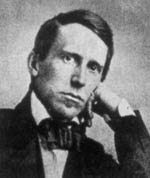
A melodic genius with tender, sympathetic lyrics and infectious rhythm, Stephen Foster is often credited as "America's First Composer" and widely regarded as one of the first who made professional songwriting profitable. Fosters' songs were the first genuinely American in theme, characterizing love of home, American temperament, river life and work, politics, battlefields, slavery and plantation life.
A self-taught musician, his poems and melodies were written in a simple manner with little musical embellishment or complexity. His work mirrored a kind, modest and sympathetic personality. In a sentimental style inspired by the simplicity of southern plantation music, Foster wrote such songs as "Old Folks At Home", "My Old Kentucky Home", "Oh! Susana" and "Old Black Joe". These songs, and many others from the Foster catalog, brought recognition and validity to Negro songs.
Stephen Collins Foster was born in Lawrenceville, Pennsylvania on July 4, 1826, to a politically and socially prominent Pittsburgh family. His father, William Barclay Foster, was a member of the Pennsylvania State Legislature and the mayor of Allegheny City (a Pittsburgh suburb). Stephen Foster was the youngest of eleven children from William and his wife, Eliza Clayland Tomlinson Foster.
In 1840, Foster attended Allegheny Academy, the first of three failed scholarly attempts, followed by Athens Academy and Towanda Academy. At Athens, the fourteen-year old Foster wrote his first song "The Tioga Waltz" (not published until after his death). In July 1841, Foster enrolled in Jefferson College at Canonsburg, PA, however struck with desperate homesickness, his attendance lasted 1 week and from 1841 to 1846, he lived with his family in Pittsburgh doing private study. (1)
A self-taught musician, his poems and melodies were written in a simple manner with little musical embellishment or complexity. His work mirrored a kind, modest and sympathetic personality. In a sentimental style inspired by the simplicity of southern plantation music, Foster wrote such songs as "Old Folks At Home", "My Old Kentucky Home", "Oh! Susana" and "Old Black Joe". These songs, and many others from the Foster catalog, brought recognition and validity to Negro songs.
Stephen Collins Foster was born in Lawrenceville, Pennsylvania on July 4, 1826, to a politically and socially prominent Pittsburgh family. His father, William Barclay Foster, was a member of the Pennsylvania State Legislature and the mayor of Allegheny City (a Pittsburgh suburb). Stephen Foster was the youngest of eleven children from William and his wife, Eliza Clayland Tomlinson Foster.
In 1840, Foster attended Allegheny Academy, the first of three failed scholarly attempts, followed by Athens Academy and Towanda Academy. At Athens, the fourteen-year old Foster wrote his first song "The Tioga Waltz" (not published until after his death). In July 1841, Foster enrolled in Jefferson College at Canonsburg, PA, however struck with desperate homesickness, his attendance lasted 1 week and from 1841 to 1846, he lived with his family in Pittsburgh doing private study. (1)
Robert Johnson
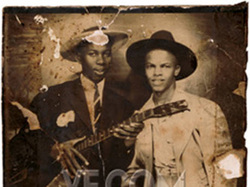
One hundred years ago, a boy-child was born in Mississippi – a dirt-poor, African-American who would grow up, learn to sing and play the blues, and eventually achieve worldwide renown. In the decades after his death, he has become known as the King of the Delta Blues Singers, his music expanding in influence to the point that rock stars of the greatest magnitude – the Rolling Stones, Bob Dylan, Eric Clapton, the Allman Brothers – all sing his praise and have recorded his songs.
That boy-child was Robert Johnson, an itinerant blues singer and guitarist who lived from 1911 to 1938. He recorded 29 songs between 1936 and ‘37 for the American Record Corporation, which released eleven 78rpm records on their Vocalion label during Johnson¹s lifetime, and one after his death.
Most of these tunes have attained canonical status, and are now considered enduring anthems of the genre: “Cross Road Blues,” “Love In Vain,” “Hellhound On My Trail,” “I Believe I¹ll Dust My Broom,” “Walking Blues,” “Sweet Home Chicago.”
Like many bluesmen of his day, Johnson plied his craft on street corners and in jook joints, ever rambling and ever lonely – and writing songs that romanticized that existence. But Johnson accomplished this with such an unprecedented intensity, marrying his starkly expressive vocals with a guitar mastery, that his music has endured long after the heyday of country blues and his own short life.
Never had the hardships of the world been transformed into such a poetic height; never had the blues plumbed such an emotional depth. Johnson took the intense loneliness, terrors and tortuous lifestyle that came with being an African-American in the South during the Great Depression, and transformed that specific and very personal experience into music of universal relevance and global reach. “You want to know how good the blues can get?” Keith Richards once asked, answering his own question: “Well, this is it.” Eric Clapton put it more plainly: “I have never found anything more deeply soulful than Robert Johnson.”
The power of Johnson’s music has been amplified over the years by the fact that so little about him is known and what little biographical information we now have only revealed itself at an almost glacial pace. Myths surrounding his life took over: that he was a country boy turned ladies’ man; that he only achieved his uncanny musical mastery after selling his soul to the devil. Even the tragedy of his death seemed to grow to mythic proportion: being poisoned by a jealous boyfriend then taking three days to expire, even as the legendary talent scout John Hammond was searching him out to perform at Carnegie Hall in New York City.
In 1990, Sony Legacy produced and released the 2-CD box set Robert Johnson: The Complete Recordings to widespread critical acclaim and, for a country blues reissue, unprecedented sales. The Complete Recordings proved the existence of a potential market for music from the deepest reaches of Sony¹s catalog, especially if buoyed by a strong story with mainstream appeal. Johnson¹s legend continues to attract an ever-widening audience, with no sign of abating. If, in today¹s world of hip-hop and heavy metal, a person knows of only one country blues artist, odds are it is Robert Johnson. (2)
That boy-child was Robert Johnson, an itinerant blues singer and guitarist who lived from 1911 to 1938. He recorded 29 songs between 1936 and ‘37 for the American Record Corporation, which released eleven 78rpm records on their Vocalion label during Johnson¹s lifetime, and one after his death.
Most of these tunes have attained canonical status, and are now considered enduring anthems of the genre: “Cross Road Blues,” “Love In Vain,” “Hellhound On My Trail,” “I Believe I¹ll Dust My Broom,” “Walking Blues,” “Sweet Home Chicago.”
Like many bluesmen of his day, Johnson plied his craft on street corners and in jook joints, ever rambling and ever lonely – and writing songs that romanticized that existence. But Johnson accomplished this with such an unprecedented intensity, marrying his starkly expressive vocals with a guitar mastery, that his music has endured long after the heyday of country blues and his own short life.
Never had the hardships of the world been transformed into such a poetic height; never had the blues plumbed such an emotional depth. Johnson took the intense loneliness, terrors and tortuous lifestyle that came with being an African-American in the South during the Great Depression, and transformed that specific and very personal experience into music of universal relevance and global reach. “You want to know how good the blues can get?” Keith Richards once asked, answering his own question: “Well, this is it.” Eric Clapton put it more plainly: “I have never found anything more deeply soulful than Robert Johnson.”
The power of Johnson’s music has been amplified over the years by the fact that so little about him is known and what little biographical information we now have only revealed itself at an almost glacial pace. Myths surrounding his life took over: that he was a country boy turned ladies’ man; that he only achieved his uncanny musical mastery after selling his soul to the devil. Even the tragedy of his death seemed to grow to mythic proportion: being poisoned by a jealous boyfriend then taking three days to expire, even as the legendary talent scout John Hammond was searching him out to perform at Carnegie Hall in New York City.
In 1990, Sony Legacy produced and released the 2-CD box set Robert Johnson: The Complete Recordings to widespread critical acclaim and, for a country blues reissue, unprecedented sales. The Complete Recordings proved the existence of a potential market for music from the deepest reaches of Sony¹s catalog, especially if buoyed by a strong story with mainstream appeal. Johnson¹s legend continues to attract an ever-widening audience, with no sign of abating. If, in today¹s world of hip-hop and heavy metal, a person knows of only one country blues artist, odds are it is Robert Johnson. (2)
Cab Calloway
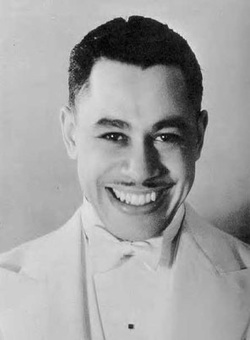
The legendary "Hi De Ho" man -- was a energetic showman, gifted singer, talented actor and trendsetting fashion plate. A truly "larger than life" figure in American pop culture, immortalized in cartoons and caricatures, Calloway also led one of the greatest bands of the Swing Era.
The middle-class Calloway family hoped their son would become a lawyer like his father. But young Cabell, born in Rochester, New York, on Christmas Day in 1907, and raised primarily in Baltimore, Maryland, wanted to be an entertainer. Cab did attend law school in Chicago, but the hours past sunset found him performing in local nighclubs.
It was in such a club where he met trumpeter Louis Armstrong, who taught him to sing in the scat style. Calloway's oldest sister Blanche was also a professional singer, and she helped him land a stage role on the road with the "Plantation Days" revue in 1925.
Eventually, Cab left law school to sing with a band called the Alabamians. While on the road, the group went head-to-head, (and state vs. state!) in a battle-of-the-bands with a mid-west ensemble, the Missourians. After the dust settled, The Missourians had won -- Cab would later join and then lead the group. (3)
http://www.youtube.com/watch?v=esnDnIK2v1g
The middle-class Calloway family hoped their son would become a lawyer like his father. But young Cabell, born in Rochester, New York, on Christmas Day in 1907, and raised primarily in Baltimore, Maryland, wanted to be an entertainer. Cab did attend law school in Chicago, but the hours past sunset found him performing in local nighclubs.
It was in such a club where he met trumpeter Louis Armstrong, who taught him to sing in the scat style. Calloway's oldest sister Blanche was also a professional singer, and she helped him land a stage role on the road with the "Plantation Days" revue in 1925.
Eventually, Cab left law school to sing with a band called the Alabamians. While on the road, the group went head-to-head, (and state vs. state!) in a battle-of-the-bands with a mid-west ensemble, the Missourians. After the dust settled, The Missourians had won -- Cab would later join and then lead the group. (3)
http://www.youtube.com/watch?v=esnDnIK2v1g
Elvis Presley
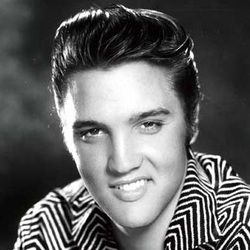
Elvis Aaron Presley was born to Vernon and Gladys Presley in a two-room house in Tupelo, Mississippi, on January 8, 1935. His twin brother, Jessie Garon, was stillborn, leaving Elvis to grow up as an only child. He and his parents moved to Memphis, Tennessee, in 1948, and Elvis graduated from Humes High School there in 1953.
Elvis’ musical influences were the pop and country music of the time, the gospel music he heard in church and at the all-night gospel sings he frequently attended, and the black R&B he absorbed on historic Beale Street as a Memphis teenager.
In 1954, Elvis began his singing career with the legendary Sun Records label in Memphis. In late 1955, his recording contract was sold to RCA Victor. By 1956, he was an international sensation. With a sound and style that uniquely combined his diverse musical influences and blurred and challenged the social and racial barriers of the time, he ushered in a whole new era of American music and popular culture.
He starred in 33 successful films, made history with his television appearances and specials, and knew great acclaim through his many, often record-breaking, live concert performances on tour and in Las Vegas. Globally, he has sold over one billion records, more than any other artist. His American sales have earned him gold, platinum or multi-platinum awards. Among his many awards and accolades were 14 Grammy nominations (3 wins) from the National Academy of Recording Arts & Sciences, the Grammy Lifetime Achievement Award which he received at age 36, and his being named One of the Ten Outstanding Young Men of the Nation for 1970 by the United States Jaycees. Without any of the special privileges, his celebrity status might have afforded him, he honorably served his country in the U.S. Army.
His talent, good looks, sensuality, charisma, and good humor endeared him to millions, as did the humility and human kindness he demonstrated throughout his life. Known the world over by his first name, he is regarded as one of the most important figures of twentieth century popular culture. Elvis died at his Memphis home, Graceland, on August 16, 1977. (4)
Elvis’ musical influences were the pop and country music of the time, the gospel music he heard in church and at the all-night gospel sings he frequently attended, and the black R&B he absorbed on historic Beale Street as a Memphis teenager.
In 1954, Elvis began his singing career with the legendary Sun Records label in Memphis. In late 1955, his recording contract was sold to RCA Victor. By 1956, he was an international sensation. With a sound and style that uniquely combined his diverse musical influences and blurred and challenged the social and racial barriers of the time, he ushered in a whole new era of American music and popular culture.
He starred in 33 successful films, made history with his television appearances and specials, and knew great acclaim through his many, often record-breaking, live concert performances on tour and in Las Vegas. Globally, he has sold over one billion records, more than any other artist. His American sales have earned him gold, platinum or multi-platinum awards. Among his many awards and accolades were 14 Grammy nominations (3 wins) from the National Academy of Recording Arts & Sciences, the Grammy Lifetime Achievement Award which he received at age 36, and his being named One of the Ten Outstanding Young Men of the Nation for 1970 by the United States Jaycees. Without any of the special privileges, his celebrity status might have afforded him, he honorably served his country in the U.S. Army.
His talent, good looks, sensuality, charisma, and good humor endeared him to millions, as did the humility and human kindness he demonstrated throughout his life. Known the world over by his first name, he is regarded as one of the most important figures of twentieth century popular culture. Elvis died at his Memphis home, Graceland, on August 16, 1977. (4)
Don Peake
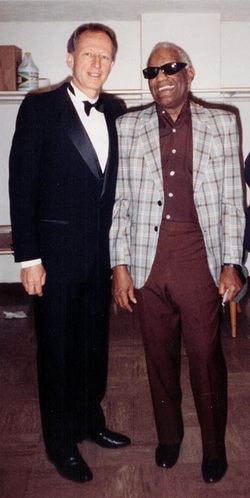
Don Peake is a multi-talented musician who has worked as a guitarist, arranger, record producer, and film music composer. Starting his professional musical career as a guitarist in 1961, Peake's talent was recognized early when he toured as lead guitarist with the Everly Brothers at the age of 21, playing in the U.S. and Europe for two years. Peake returned to Los Angeles to establish himself as a recording musician, and played for many of the legendary performers under Phil Spector's production including The Righteous Brothers - "You've Lost That Loving Feeling", Ike and Tina Turner - " River Deep Mountain High", as well as recording with Mahalia Jackson, Billy Preston, Cannonball Adderly, Marvin Gaye, and Diana Ross.
In 1964, Peake became the first white guitarist to play with the Ray Charles Orchestra, touring with Charles, and recording with him for ten years. During that time, Peake studied guitar with Barney Kessel, Howard Roberts, and Joe Pass, three legendary guitarists. Peake became one of the premiere session guitarists in Los Angeles, recording for Jan and Dean, The Mamas and the Papas, Sonny and Cher, The Beach Boys, and many others. Don was inducted into an elite group of musicians led by drummer Hal Blaine known as "The Wrecking Crew". (4.1)
In 1964, Peake became the first white guitarist to play with the Ray Charles Orchestra, touring with Charles, and recording with him for ten years. During that time, Peake studied guitar with Barney Kessel, Howard Roberts, and Joe Pass, three legendary guitarists. Peake became one of the premiere session guitarists in Los Angeles, recording for Jan and Dean, The Mamas and the Papas, Sonny and Cher, The Beach Boys, and many others. Don was inducted into an elite group of musicians led by drummer Hal Blaine known as "The Wrecking Crew". (4.1)
Eric Clapton
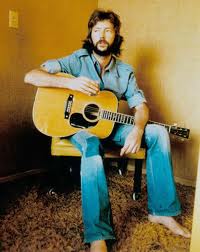
Eric Patrick Clapton was born on 30 March 1945 in his grandparents’ home at 1 The Green, Ripley, Surrey, England. He was the son of 16-year-old Patricia Molly Clapton (b. 7 January 1929, d. March 1999) and Edward Walter Fryer (b. 21 March 1920, d. 1985), a 24-year-old Canadian soldier stationed in England during World War II. Before Eric was born, Fryer returned to his wife in Canada.
It was extraordinarily difficult for an unmarried 16-year-old to raise a child on her own in the mid-1940s. Pat’s parents, Rose and Jack Clapp, stepped in as surrogate parents and raised Eric as their own. Thus, he grew up believing his mother was his sister. His grandparents never legally adopted him, but remained his legal guardians until 1963. Eric’s last name comes from Rose’s first husband and Pat’s father, Reginald Cecil Clapton (d. 1933). (5)
more...
It was extraordinarily difficult for an unmarried 16-year-old to raise a child on her own in the mid-1940s. Pat’s parents, Rose and Jack Clapp, stepped in as surrogate parents and raised Eric as their own. Thus, he grew up believing his mother was his sister. His grandparents never legally adopted him, but remained his legal guardians until 1963. Eric’s last name comes from Rose’s first husband and Pat’s father, Reginald Cecil Clapton (d. 1933). (5)
more...
The Who
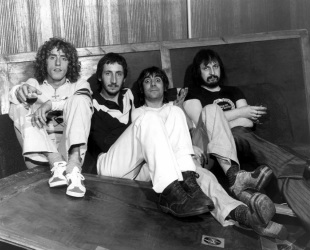
1944
1 March – Roger Harry Daltrey born in Shepherds Bush, London.
9 October – John Alec Entwistle born in Chiswick, London.
1945
19 May – Peter Dennis Blandford Townshend born in Chiswick, London. His father, Cliff, is a professional saxophonist and his mother, Betty, is a singer.
1946
23 August – Keith John Moon born in Wembley, Middlesex.
1959
Pete and John form The Confederates, a trad jazz outfit, while at Acton County School. Pete plays the banjo and John the French horn. Roger attends the same school, a year ahead of them.
1961
In September, Pete enrolls at Ealing Art School; art college being the classic training ground for British rock stars of the Sixties, while John works for the Acton tax office. Roger becomes a sheet metal worker, building his own guitars. His group, The Detours, originally a skiffle group, formed at Acton County School recruits John on bass guitar.
1962
Pete is added on guitar at John’s suggestion. Behind the drums is Doug Sandom and Colin Dawson is the up-front vocalist.
Keith, unknown to Pete, Roger and John at this point, starts the first of what he estimates to have been "23 jobs in two years". He also plays drums with the group, Mark Twain and The Strangers.
1963
After Colin Dawson is kicked out by Roger who takes over the lead vocal spot from fill-in vocalist Gabby Connolly, The Detours become a hard working semi-pro rock’n’roll/R&B quartet on the west London circuit of pubs, clubs and ballrooms.
1964
In February, The Detours change their name to The Who at the suggestion of Pete’s art school friend Richard Barnes. The Who acquire the managerial services of Helmut Gorden, a doorknob manufacturer from Shepherd’s Bush.
In April, after an impromptu audition at the Oldfield Hotel in Greenford, west London, Keith Moon, who had been drumming for the past year in local Wembley group, Clyde Burns and The Beachcombers, joins The Who. The group had been using a session drummer Dave Golding following the departure of Doug Sandom. (6)
More...
1 March – Roger Harry Daltrey born in Shepherds Bush, London.
9 October – John Alec Entwistle born in Chiswick, London.
1945
19 May – Peter Dennis Blandford Townshend born in Chiswick, London. His father, Cliff, is a professional saxophonist and his mother, Betty, is a singer.
1946
23 August – Keith John Moon born in Wembley, Middlesex.
1959
Pete and John form The Confederates, a trad jazz outfit, while at Acton County School. Pete plays the banjo and John the French horn. Roger attends the same school, a year ahead of them.
1961
In September, Pete enrolls at Ealing Art School; art college being the classic training ground for British rock stars of the Sixties, while John works for the Acton tax office. Roger becomes a sheet metal worker, building his own guitars. His group, The Detours, originally a skiffle group, formed at Acton County School recruits John on bass guitar.
1962
Pete is added on guitar at John’s suggestion. Behind the drums is Doug Sandom and Colin Dawson is the up-front vocalist.
Keith, unknown to Pete, Roger and John at this point, starts the first of what he estimates to have been "23 jobs in two years". He also plays drums with the group, Mark Twain and The Strangers.
1963
After Colin Dawson is kicked out by Roger who takes over the lead vocal spot from fill-in vocalist Gabby Connolly, The Detours become a hard working semi-pro rock’n’roll/R&B quartet on the west London circuit of pubs, clubs and ballrooms.
1964
In February, The Detours change their name to The Who at the suggestion of Pete’s art school friend Richard Barnes. The Who acquire the managerial services of Helmut Gorden, a doorknob manufacturer from Shepherd’s Bush.
In April, after an impromptu audition at the Oldfield Hotel in Greenford, west London, Keith Moon, who had been drumming for the past year in local Wembley group, Clyde Burns and The Beachcombers, joins The Who. The group had been using a session drummer Dave Golding following the departure of Doug Sandom. (6)
More...
References:
(1) http://www.songwritershalloffame.org/exhibits/C10(2) http://www.robertjohnsonbluesfoundation.org/biography
(3) http://www.npr.org/programs/jazzprofiles/archive/calloway.html
(4) http://www.elvis.com/about-the-king/biography_.aspx
(4.1) http://www.donpeakemusic.com/DP_pages/Don_Peake_bio.html
(5) http://www.ericclapton.com/eric-clapton-biography
(6) http://www.thewho.com/index.php?module=history
(1) http://www.songwritershalloffame.org/exhibits/C10(2) http://www.robertjohnsonbluesfoundation.org/biography
(3) http://www.npr.org/programs/jazzprofiles/archive/calloway.html
(4) http://www.elvis.com/about-the-king/biography_.aspx
(4.1) http://www.donpeakemusic.com/DP_pages/Don_Peake_bio.html
(5) http://www.ericclapton.com/eric-clapton-biography
(6) http://www.thewho.com/index.php?module=history
